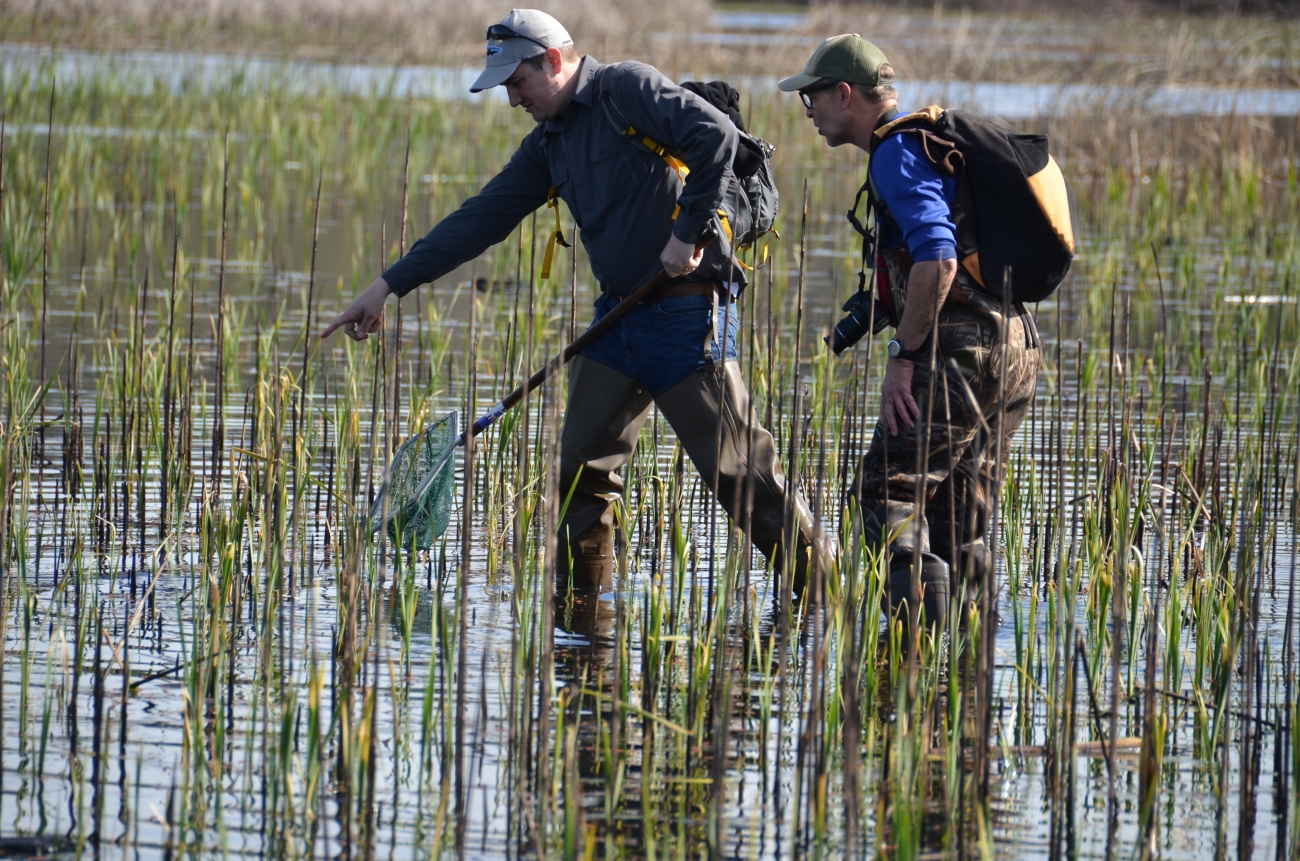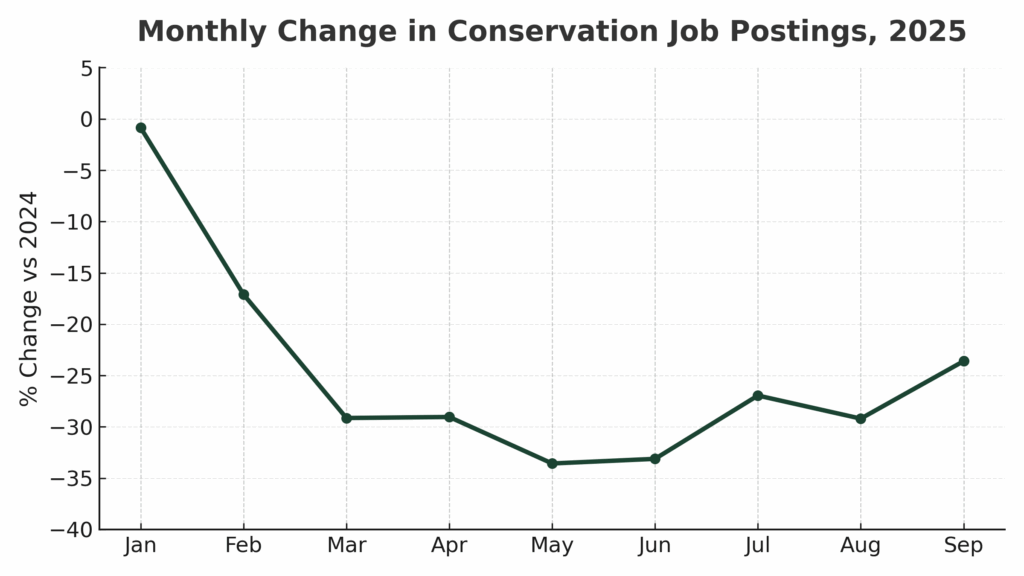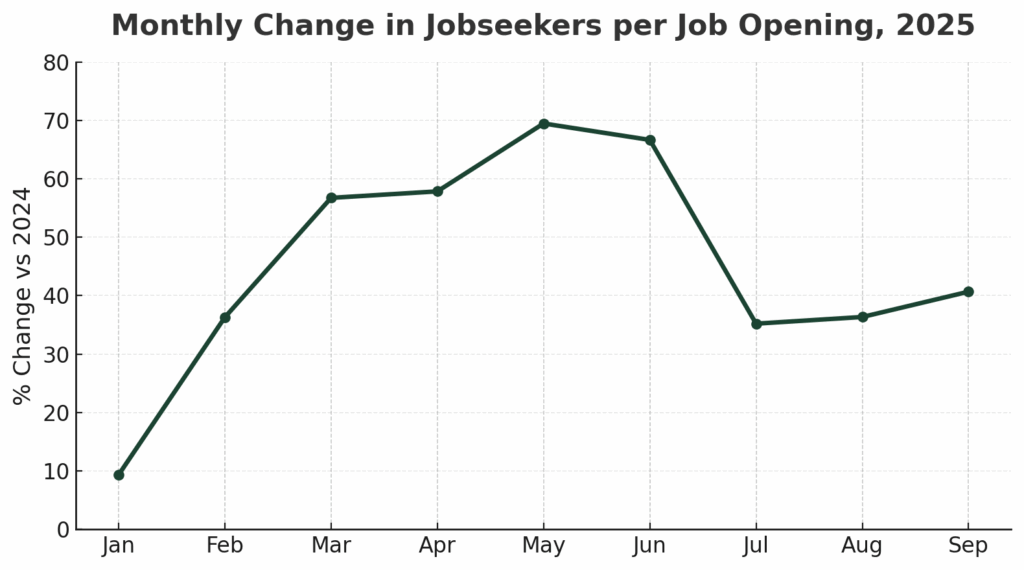Conservation Jobs Fall Sharply in 2025
2025 Conservation Jobs Report: Job postings down, jobseeker competition up.

Summary
The conservation workforce includes the people and organizations that protect, manage, and study nature. These are the jobs responsible for our parks, forests, wildlife, and water resources.
To understand trends in conservation hiring in the United States, we analyzed job posting data from 2025, 2024, and 2023. We also surveyed 337 conservation employers in March–April 2025 about expectations and reasons for changes in hiring.
We found that non-federal conservation hiring in the United States began to collapse by mid-February 2025.
From March 1–September 30, 2025, postings on Conservation Job Board fell 29.4% year over year (YOY). This was a sudden downturn. Total postings in 2024 increased 5.4% YOY.
These include jobs with state and local agencies, nonprofits, universities, and private-sector employers. This count also includes non-federal jobs that work in partnership with federal agencies, such as conservation corps and nonprofit partners. Altogether, they represent the majority of the conservation workforce.
Postings have fallen more sharply for federal jobs. However, the low volume of federal listings on third-party sites such as Conservation Job Board makes year-to-year comparisons less reliable.
Results
A Stable 2024 Turned into a 2025 Collapse
Figure 1. Monthly change in conservation job postings, 2025. — Source: Conservation Job Board internal analytics.
The 2025 hiring decline was not only sharp but also sudden. Conservation Job Board data show a relatively stable job market in 2024, with total postings increasing 5.4% YOY to 15,991 listings.
Postings for non-federal jobs fell 0.8% in January 2025. In February, postings fell 17%. In March, they fell 29%, and the decline continued through the summer, hovering around a 30% YOY drop. The decline moderated slightly to 23.6% in September. However, preliminary October data suggest the downturn is not yet reversing.
We suspect that the figures from January and February understate the level of hiring decline in those months. We received some reports from employers about jobs posted in January and February that were ultimately canceled or delayed due to federal funding freezes and uncertainty.
Jobseeker Competition Heats Up
Figure 2. Monthly change in jobseekers per job opening, 2025. — Source: Conservation Job Board internal analytics.
Jobseeker competition has surged. Average monthly jobseeker traffic increased 7.7% in 2025. However, we assess job-search competitiveness by comparing the number of jobseekers to job openings. The jobseekers-per-job ratio increased 40% for the period of January–September.
Job-search competitiveness:
- 84 jobseekers per job opening in 2024
- 117 jobseekers per job opening in 2025
The YOY increase in job-search competitiveness peaked from March–June. This period saw the steepest declines in hiring along with the largest increases in traffic. This pattern likely reflects a lag between the federal funding freeze imposed in January and February and its full effect on seasonal hiring and job search, which normally peaks from January–April for the summer field season. Federal layoffs in February likely intensified jobseeker competition further.
Breakdown by Job Type and Key Trends
We examined how different job types fared during the period of steepest decline: March 1-August 30 (2025 vs. 2024).
% Changes by Job Type:
- Permanent Jobs -32.8%
- Seasonal/temporary Jobs -15.8%
- Paid internships -43.8%
- AmeriCorps -42%
Paid internships and AmeriCorps positions suffered the biggest losses. These are critically important pipelines for early-career development in conservation.
Permanent jobs are typically full-time positions with benefits and no defined end date. These are the secure roles that professionals rely on for a stable livelihood. Seasonal and temporary jobs tend to offer lower pay, fewer (or no) benefits, and less stability. However, they have long played an important role in conservation due to the short timeframes of project fieldwork and the need to staff up parks during peak visitation periods.
The relative performance of these job types suggests that employers are increasingly relying on seasonal workers over permanent staff to meet operational needs. This trend is problematic for worker livelihoods and the viability of conservation as a career pathway.
Signs of Federal Decline but Uncertain Figures
Most conservation hiring happens with non-federal employers—state and local agencies, nonprofits, universities, and the private sector. Nevertheless, the federal government is the single largest employer in conservation.
Yet, federal hiring trends are harder to analyze. Most federal jobs are posted exclusively on USAJOBS rather than third-party sites such as Conservation Job Board. Furthermore, recruiting practices may have shifted under the new administration, given its major operational changes.
The data suggest that federal hiring declined sharply in 2025: federal postings to Conservation Job Board fell roughly 60%. However, because federal postings are a small share of total listings (less than 5%), direct comparisons between 2024 and 2025 are less reliable.
Cautious Employer Outlook
In March and April 2025, we surveyed 337 conservation employers about their hiring expectations for the rest of the year. Their responses indicate that caution has taken hold.
Employer expectations for 2025 hiring:
- 42% expected to hire fewer people than the same period in 2024.
- 35% expected to hire the same number.
- 16% expected to hire more.
- 8% weren’t sure.
Organizations expecting to reduce hiring in 2025 outnumbered those expecting to increase hiring nearly 3:1. This suggests that the hiring slowdown will persist through the remainder of the year.
In our survey, employers were asked to give reasons for expected changes in hiring.
The most common employer reasons for expected declines:
- Reduced or uncertain federal funding
- The general state of the economy and rising costs
- Leadership caution
Subscribe to Works for Nature
Get our articles by email.
Discussion
Exploring the Causes of the Hiring Downturn
Below, we explore why the conservation job market has been collapsing. The employer responses from our survey and the timing of the sharp decline in job postings point to likely causes.
DOGE Impacts
The timing of the hiring downturn lines up with the Trump administration’s newly created Department of Government Efficiency (DOGE) and its early policy shifts.
In January 2025, DOGE began freezing billions of dollars in environmental and research grants. The freeze directly affected a wide range of non-federal conservation employers that had been awarded grants and were relying on them for hiring. Within weeks, the freeze expanded into widespread, long-term delays—and in many cases outright cancellations—of funding that Congress had already approved.
In April, the cuts spread to AmeriCorps, including its conservation programs, where thousands of members were terminated mid-service. Field crews were pulled from restoration, trail building, and education projects nationwide.
Together, these disruptions likely played a major role in the decline of conservation hiring in 2025.
State of the Economy
The broader economic environment likely contributed to the decline in new conservation jobs. Conservation employers cited rising costs, economic uncertainty, and leadership caution as reasons for expected changes in 2025 hiring. Furthermore, these trends have coincided with a downturn in the broader labor market nationally.
Federal Hiring Impacts
While our data review focuses primarily on non-federal employers, the hiring collapse clearly extended into the federal conservation workforce. The administration froze hiring across multiple agencies, including the National Park Service, U.S. Fish and Wildlife Service, and U.S. Forest Service.
Some seasonal hiring appeared to resume by March. However, an analysis of Department of Interior internal data found that the administration was falling well short of its seasonal staffing goals.
Anecdotal reports have proliferated: seasonal rangers never got callbacks; research fellows saw their start dates “postponed indefinitely.” Many of those jobs likely vanished.
Why it Matters
Nature Conservation is a Workforce
Nature conservation provides wide-ranging benefits to society. It means parks, outdoor recreation, healthy wildlife, clean water, sustainable natural resources, and public safety from fires and flooding. But it takes a workforce to make conservation happen. A collapse in hiring, coupled with federal layoffs, threatens those benefits and services.
News reporting and surveys give us glimpses of the impacts: a struggling National Park System, disruption to ecological research, cancellation of habitat restoration projects, and termination of trail building and maintenance crews.
A 30% decline in conservation hiring means this is just the tip of the iceberg.
Conservation Employment Fuels Local Economies
Conservation jobs provide livelihoods for tens of thousands of Americans, from trail builders and wildlife biologists to park planners and lab technicians. A decline in conservation hiring means increased hardship and struggle for people.
The field of conservation is the cornerstone of a multibillion-dollar, outdoor recreation and tourism sector. For example, National Parks visitors contributed $29 billion in spending to local communities in 2024, supporting 340,000 jobs. Cuts to conservation put the entire outdoor recreation and tourism sector at risk.
The Erosion of Expertise and the Future Workforce
The cuts to conservation are hitting both ends of the professional ladder. Early-career pipelines are disappearing. AmeriCorps positions and internships have fallen more than 40 percent. These are important pathways for conservation professional development.
Meanwhile, layoffs and attrition at federal agencies are erasing decades of expertise. These are the specialists who manage our national parks. These are the experts who run complex programs to save endangered species.
Together, these losses could lead to a void in leadership and skills that could take years to recover.
Closing Thought
Conservation hiring isn’t just a labor statistic. It’s a measure of how seriously the United States is investing in its land, water, wildlife, and communities. When conservation jobs disappear, so does our capacity to protect, manage, and study nature.
Methods
Understanding the State of the Conservation Job Market
Conservation Job Board provides a lens for understanding annual hiring trends in the field of nature conservation. The site was launched in 2010 and offers free job postings to employers. Now 15 years old, it reaches a large, stable audience of job seekers and employers, broadly covering the extent of the field. In 2024, it received 15,991 total job postings. The website has not undergone any major changes in design, functionality, or marketing since January 1, 2023.
We believe that changes in job posting volume on the website can indicate hiring trends in the field. Posting volume can also change for unrelated reasons (e.g., business performance), but if those factors were the drivers, we would expect a corresponding shift in total audience reach. To control for that, we also examined trends in total website visitors.
Methodology
We measured the monthly volume of US-based jobs posted on Conservation Job Board in 2023, 2024, and 2025 (through September 30, 2025). To understand trends in hiring, we calculated YOY percent change in 2024 and 2025 by month.
To see how trends varied across the field, we repeated measurements for: a) federal vs. non-federal jobs; and b) permanent, seasonal, internship, and AmeriCorps positions.
We also measured monthly and total U.S.-based website users in 2024 and 2025 and calculated the percent change from 2024 to 2025. The total number of users grew ~2%, suggesting that business factors were unlikely to be driving major changes in posting volume. We therefore did not adjust the posting data for business effects.
We then assessed trends in job search competitiveness by calculating jobseekers per posting for 2024 and 2025.
Lastly, to inform our understanding of the motivations behind trends, we reviewed results from a survey conducted in March–April 2025 from 337 conservation employers. The survey asked about expected hiring for the remainder of 2025 and the factors influencing any changes.
About the Authors
Rob Goldstein founded Conservation Job Board in 2010 and Works for Nature in 2025. He holds an M.S. in Human Dimensions of Natural Resources from Colorado State University and has worked in the conservation field for over 20 years.
Swapnika Gupta and Kouceyla Hadji assisted with data collection and analysis.

